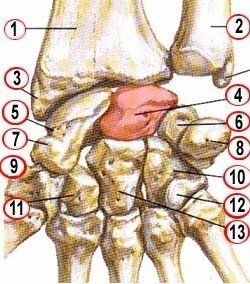- Elle-Spoke Cartilage surface on the ElleOS lunate bone (lunar bone) OS scaphoideum (scaphoid bone) OS triquetrum (triangular bone) OS scaphoideum (scaphoid bone) OS pisiformes (pea bone) OS trapezium (large polygonal bone) OS humatum (hooked bone) OS trapezoidal (humectomy) Hook bone) OS Capitatum (head bone)
What is lunate malacia?
The lunate malacia, also known under the names "lunate necrosis", "Morbus Kienböck", "Kienböck disease", "lunar bone death" and "lunar bone necrosis" is a rare and mostly late (also too late) recognized disease of the lunar bone (Latin: lunatum). The lunar bone, in turn, is a wrist bone (see sketch)
A lunate malazia (in German: softening of the moon bone) is now partially recognized as an occupational disease in manual professions. It often occurs in professions in which devices are often used that cause constant vibration of the wrist (such as grinders, drills, vibrators, etc.). However, in most cases this disease is considered too late by doctors because it occurs quite rarely. A doctor once said: "For every 1,000 to 10,000 people, about 1 to 2 come into contact with this disease." In most cases, a misdiagnosis is made. Such as the tendinitis that occurs again and again.
Lunate malacia affects men more often than women. The disease progresses slowly. Symptoms are tenderness in the wrist, slight to severe swelling of the wrist when exerted. The fingers may be swollen and there may be pain in the entire palm and fingers.
In the case of lunate malacia, the lunar bone decomposes itself. Most of the time, the decomposition can be traced back to a circulatory disorder, which may occur due to a malposition or formation of the ulna (such a malposition is detected in approx. 20% of all patients). Furthermore, a defect in the blood vessels in the region of the lunar bone or trauma due to accidents can be the cause.
In the specialist jargon, lunate malacia is referred to as aseptic necrosis of the lunar bone, which can lead to increasing bone softening and later to wrist arthrosis. This means that the bone no longer has the appropriate density that it needs. The bone becomes soft and porous and can splinter. Because of the lack of blood circulation, the bone does not get the substances or the amount of substances it needs (such as oxygen and calcium).
This is difficult to understand, especially for those not affected and / or relatives. A comparison is often made with a normal fracture of the arm. However, this comparison is not accurate.
Likewise, the limitations during the healing phase after an operation cannot be compared with a broken arm:
- The period of time (occurrence of the pain to diagnosis; OP to recognizable OP success; possibly even up to the 2nd or even 3rd OP / healing attempt and its healing phase) is much greater. Getting caught "with the affected hand on - for those not affected - incomprehensible little things (e.g. brief, unpredictable, jerky touch of a fixed piece of furniture ..) associated with pain. Likewise every grip, every movement with pain, Relearning motor skills after an operation
The disease is also called as follows: lunate necrosis, Kienböck's disease, lunar bone death, lunar bone necrosis, Kienböck disease - to English: Kienboeck's disease.







